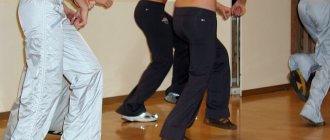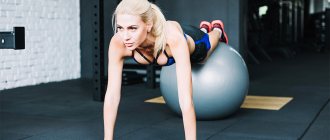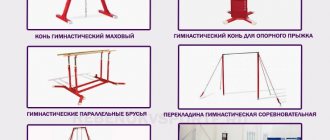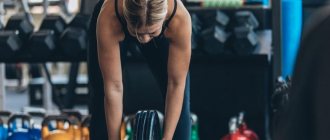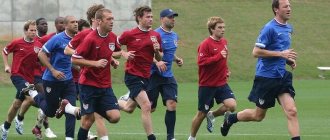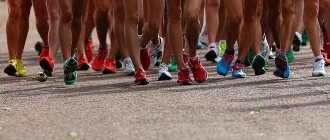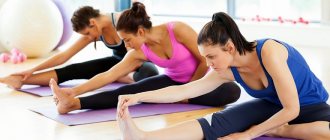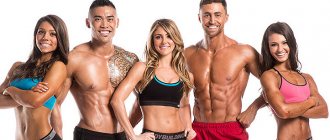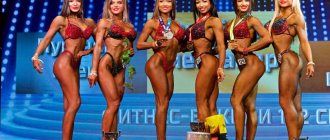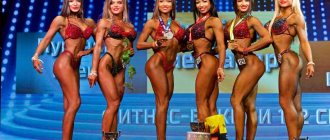Sports aerobics is an energetic, beautiful sport that combines elements of acrobatics and dance. This direction of gymnastics requires the athlete to have strong motivation, general endurance, vestibular stability and excellent plasticity. Many parents, when choosing a class for their child, very often act under the influence of the stereotype that aerobics is an activity exclusively for girls. Sports aerobics not only trains the body, but also develops personal qualities and teaches teamwork, which is very important in adult life, regardless of gender.
What is sports aerobics?
Sports aerobics is a branch of gymnastics, the peculiarity of which is to perform artistic movements to rhythmic music. Unlike fitness, it is a real sport where gymnasts demonstrate coordination, agility, strength and flexibility. International competitions in sports aerobics have been organized for a long time.
Athletes' performances combine acrobatic and dance elements and usually last 1-2 minutes, depending on the complexity of the set of exercises and the age of the participants.
The nature of the competition, the form of its holding
All age categories are allowed to compete. Competitions are organized in the following disciplines:
- Dance gymnastics;
- Gymnastic platform;
- Group (5 athletes);
- Trio;
- Mixed couples;
- Individual performances.
The competition is held in two rounds:
- Preliminary;
- Final.
By the nature of the competition they are personal (that is, the jury determines only the personal results of the participants in the relevant groups).
Age categories
Gymnasts of all ages can take part in sports aerobics competitions, namely:
- Children: Younger age group (6-8 years);
- Senior age group (9-11 years);
When a certain standard of points is met, depending on the age of the competitor, he may be assigned the following rank:
- Youth (I-III(youth)) (13-11 points) – from 7 years old;
- II and III sports categories (15 and 14 points, respectively) – from 9 years old;
- I sports category (16 points) – from 11 years;
- CMS (17 points) – from 14 years of age;
- MS (18 points) – from 15 years old;
- MSMK (18 points) – adults over 18 years of age.
Athletes have the right to compete exclusively within their age category.
Gender of participants and their number
Both women and men take part in sports aerobics competitions. The number of athletes depends on the group in which they compete:
- Individual performances involve one gymnast performing exercises;
- Mixed couples consist of a man and a woman;
- Trios include 3 athletes;
- There are 5 athletes performing in groups;
- Dance gymnastics requires the participation of 8 gymnasts;
- Gymnastics platform – 8 participants.
Performances in trios and groups, as well as in dance gymnastics and gymnastics platform are possible both with a mixed composition and participants of only one gender.
Briefly about the term “aerobics”
“Aero” means “air” in Greek. The term “aerobics” was coined by American cardiologist Kenneth Cooper. This is what he called exercises during which the body works in a cyclic mode with a relatively high heart rate . The body uses up oxygen and glycogen, as well as fat deposits if there is not enough glycogen. The most ancient type of aerobics is recreational walking.
Cooper's brainchild was reminiscent of Soviet rhythmic gymnastics and was aimed at:
- prevention of physical inactivity;
- weight loss;
- strengthening the cardiovascular system.
The system spread quickly. Some began to jump in groups in tights, which we all remember from old videos, others began to exercise to Jane Fonda videos, and still others began to jog. It is approximately in this form that aerobics exists as a modern phenomenon.
Only distinctions have been added by the types of equipment used, pulse zones and type of load.
© Kalim — stock.adobe.com
Timing of the competition
Sports aerobics competitions have strict time limits for performances. Performing a set of exercises should not take more than 1 minute 20 ± 5 seconds, regardless of the category. The frames of one performance are indicated by a sound signal, which is not included in the total duration.
As mentioned earlier, competitions are held with musical accompaniment. Nevertheless, gymnasts enter the court without it, without performing any special movements. When the team is announced, the athletes immediately take the starting position, and at the end of the complex they leave the site.
Description
Types of aerobics differ from each other in the types of exercises, their force load on the body, as well as their focus. Some classes are designed to reduce weight and increase muscle mass, while others are of a healing nature, helping to normalize the functioning of the heart, breathing, and cope with stress.
What is noteworthy is that the oldest type of aerobics is step aerobics. Moreover, this type of fitness is considered the most effective for various knee injuries.
Today there are many varieties of aerobics known. However, progress does not stand still, and many new, modern types of fitness have already been invented, gaining popularity every day. For example, bailotherapy (strengthens the muscles of the abdomen, thighs and legs), kalari-payatau (improves posture, gives flexibility) and Bosu (helps to work all the muscles of the body using a simulator similar to a flying saucer).
Musical accompaniment at competitions
Music in sports aerobics, as in dancing, is used to set a certain tempo and set the theme of the complex. It supports the performance and also influences the quality of the choreography. Well-chosen musical accompaniment can highlight the performance.
Music is selected according to the age group and category of athletes. Not every song or melody is suitable for competitions. It should reflect the plot that the choreographer put into the program, enhance its effect, and also show the style of the gymnast and his individual characteristics.
Music should have a clear rhythm and dynamics, not be monotonous and generally correspond to the essence of sports aerobics. Technically, it should be perfect, without an excessive number of inserts, and the melody should be heard better than the background and rhythmic basis.
The audio recording is provided in two copies for the competition. The copies include the names of the group members, the duration of the music track and the nomination. The song must be of excellent quality and meet all sound reproduction standards. Competitors are provided with separate headphones. The audio equipment package also includes a CD player.
How to start practicing?
Before you start doing aerobics, you should always consult your doctor. When choosing a particular type of fitness, you should first of all take into account your health status, as well as individual characteristics.
Aerobics can be done both at home and in gyms in groups or individually.
For beginners, it is advisable to go to gyms where there are instructors and exercise machines. Trainers will take into account diseases (if any), help you choose a set of exercises to restore your health, and also choose the required level of physical activity.
If you want to lose weight, then you need to exercise up to five times a week. After two months of regular training, the result will not be long in coming. If you just need to keep yourself in excellent physical shape, then you can do aerobics three times a week.
If you want to achieve an ideal figure, you need to combine various activities (for example, go to the gym twice a week and do fitness three times a week). At the same time, you need not to be lazy and go towards your goal.
Clothing requirements
Athletes must be neatly dressed and make a good impression of themselves outwardly. An emblem or national identification is attached to each gymnast's costume. For violations in appearance, a fine is expected: the chairman of the jury has the right to deduct 0.2 points according to certain criteria.
Requirements for a women's suit:
- The uniform should consist of a one-piece jumpsuit or one-piece swimsuit that completely hides the groin area, and tights (beige or transparent);
- It is allowed to wear long tights and clothes with sequins;
- Clothing with too deep necklines is not permitted. The neckline should not be lower than the middle of the sternum, and the notch at the back should not extend beyond the bottom line of the shoulder blades;
- The cut of the bottom of the swimsuit should not be higher than waist level;
- Suits with or without long sleeves are acceptable. Sleeves can be made of transparent material.
Requirements for a men's suit:
- Male gymnasts must wear shorts and a tight-fitting tank top or unitard when competing. A leotard is acceptable in combination with a dance bandage;
- Men's suits with open necklines are not permitted;
- Armholes should not extend below the shoulder blades;
- There should be no glitter on the clothing of male participants;
- One-piece jumpsuits, 3/4 leggings, and long gymnastics tights are allowed.
General requirements:
- Sneakers and socks must be exclusively white;
- Makeup is permissible only for women, and in moderation;
- The use of body paint is not permitted;
- Hair should be pulled back as tightly as possible;
- Wearing jewelry is not allowed at competitions;
- Clothing should not have additional elements that are not attached to it;
- Transparent material is only acceptable for the sleeves of women's suits;
- Wearing torn overalls and swimsuits during competitions is not permitted;
- Clothing should not be provocative, namely display violence or have a religious or military theme.
Quite often before competitions, athletes have their suits made to order. This allows not only to achieve exact compliance with the standards, but also to create a unique stage image.
Draw, admission of athletes to participate in competitions
The order in which gymnasts or groups will perform in each round is determined by lot. Athletes are required to enter the court strictly in accordance with their number. The draw is organized on the same day when the participants arrive after the preliminary commission, and takes place in the presence of a representative of the group. All important information, including the order of performances and the schedule of competitions, is pre-posted on a stand in the hall in which the competition will be held. Organizers can also send it to coaches by email.
Gymnasts who have reached a certain age in the same year in which the competition is to take place are allowed to participate in the competition. A group or club may have its own special name. Applications are submitted in accordance with the procedure established in the Competition Regulations and must be completed accordingly.
Where to start[edit | edit code]
If you are a beginner or poorly prepared physically, study for several months in a preparatory group and only then move on to classes with more complex programs. In large groups, little attention is usually paid to proper technique, so the training either does not bring any benefit, or the effect is such as overtraining. The fact is that the instructor is not able to keep track of everyone and establish contact with each participant. If you have any physical problems that may be aggravated by exercise, you should inform the group leader in advance so that he can select safe and effective exercises for you. Read more: group fitness.
Checking the venue and sound recordings before the competition
The sound recording testing procedure is carried out to prevent possible problems and incorrect playback. If the duration, speed and quality of the track do not match the planned ones, the media can be replaced during the test. Providing another flash drive or disk during the competition is possible only after obtaining the permission of the head judge.
Each athlete or team must undergo site testing. In accordance with the rules at this stage, each gymnast's performance can be adjusted. Responsibility for the quality of the music and checking the venue before the competition lies entirely with the team.
Directions and types[edit | edit code]
There are many areas of aerobics, which, as a rule, are based on cardiovascular exercises. Take aerobics with martial arts elements (tai-bo, kataboxing) or indoor cycling (Johnny Spinning). Dance aerobics classes are usually conducted in group classes accompanied by music and under the guidance of a qualified instructor. Many aerobics schools have moved away from the 1970s "no pain, no gain" philosophy and are incorporating aspects such as stabilizing muscle strengthening and strength training, including the use of exercise balls and weights.
Directions and types:
- Water aerobics
- Combat aerobics (kibo and tai-bo)
- Hydroaerobics
- Pump aerobics (body pump)
- Cycle aerobics
- Slide aerobics
- Step aerobics
- Strength aerobics
- Dance aerobics
- Fitball aerobics
Equipment and fittings of the competition hall
The hall in which the competition is planned to be held has certain requirements for technical equipment. The room should have:
- Area. Its total size must be 12 x 12 m, the competition area must be clearly delineated and be at least 10 x 10 m for adults and 7 x 7 m for some younger age categories. The width of the marking tape is taken into account.
- Location of judges. The panel judges are located directly in front of the podium, the line judges are located diagonally at the corners, and the top panel jury is located on the platform behind the panel judges.
- A training ground for athletes. The zone can be located either in the main or in an additional hall. If the warm-up area is located in the same room where the competition will be held, then it must be separated by a screen.
- Waiting area for the performance to begin. The starting area can only be occupied by two groups of athletes whose numbers will be called next, and their coaches, who will wait there for their gymnasts until the end of their routine.
- Sound engineer's area. A place for musical equipment is allocated not far from the site where the athletes will perform. The area contains tables for equipment and chairs for the cameraman and music judge.
- Place for medical personnel;
- Seats in the stands intended only for competitors and only for spectators. The spectator area should be located at a safe distance from the site.
All organizers are encouraged to film the competition, so there is also an area for a videographer in the hall. The video recording is attached to the report of the event, and can also be used to resolve controversial issues.
Procedure for filing appeals and protests
At sports aerobics competitions, the Supreme Jury deals with controversial issues and protests. It includes:
- Main judge;
- Deputy Chief Judge;
- Deputy Chief Judge for Analysis of Judicial Activities.
Only group coaches have the right to appeal. Reasons for protest may be:
- Inadequacy of the athlete for his age category;
- Unsportsmanlike behavior of competition participants, deliberate creation of obstacles to the performance of other competitors;
- Illegality of fines applied (in relation to one’s group);
- No fine (in relation to another team) in case of obvious violations.
Conditions for accepting a protest:
- Making an oral protest within 5 minutes after the announcement of the results;
- Submitting a written protest within 15 minutes after an oral one.
If the protest was not timely certified in writing, then it is not subject to consideration. The application is submitted to the chief judge for refereeing analysis, and his deputy must note the time of receipt of the complaint. The decision of the jury is not subject to appeal and is made before the announcement of the results of the competition.
Composition of the jury and duties of judges
The jury consists of a number of judges, their deputies and secretaries, namely:
- The chief judge, who directs the work of the entire panel in accordance with the rules of the competition. His responsibilities include:
- Checking the readiness of the hall and equipment for competitions;
- Instructing other jury members;
- Drawing lots for the order in which groups enter the site;
- Providing information to all competition participants, their leaders and coaches, as well as spectators and media representatives;
- Monitoring the progress of the competition.
Chief judge of law:
- Allow the group to perform again if it was canceled due to technical reasons;
- Participate in the decision on the final assessment if discrepancies arise;
- Change the order of performances of groups if objective circumstances require it;
- Suspend athletes from participation in competitions if their age does not meet the rules, as well as for unsportsmanlike behavior.
- Deputy chief judge, performing the duties of the chief judge in his absence. In turn, he is obliged:
- Ensure the presence of medical workers at competitions;
- Prepare the hall and equipment;
- Select texts for announcers approved by the chief judge.
- The chief secretary, who ensures the functioning of the secretariat. He must:
- Obey the decisions of the chief judge;
- Conduct a preliminary commission and draw up its report;
- Provide participants and judges with all necessary documentation;
- Check applications from potential competition participants;
- Prepare a final report on the event.
- Deputy Chief Secretary. His responsibilities include:
- Providing the panel of judges with competition materials;
- Filling stands and information boards during the event;
- Preparation for the awards ceremony.
- Artistic judges who evaluate the choreographic component of a set of exercises according to the criteria;
- Performance judges, who evaluate the technical skill of the participants and compare it with perfection;
- Judges of the complexity of the composition;
- Arbitrators of the judging panels who must:
- Evaluate performances;
- Monitor the judging process in your team;
- Resolve controversial issues together with the chief judge.
- Team leaders who must intervene if:
- Judges' scores are incorrect;
- There was a difficulty in grading;
- The judges did not notice the mistake.
- Line judges who ensure that competitors do not cross the demarcation tape while performing their complex. A flag serves as a signal of a violation. A deduction is provided for going beyond the boundaries of the court.
- An informant judge who announces various points throughout the event;
- Judges for the participants who supervise the movements of groups and individual athletes and take care of maintaining discipline;
- Technical Secretary;
- Music judge.
All jury members are required to act strictly in accordance with the rules and regulations for the conduct of sports aerobics competitions.
Elements of a set of exercises and minimum requirements for their implementation
All exercises are divided into groups, designated by letters from A to D. Group A: (dynamic strength) includes such elements as:
- Bending/extension of the arms while lying down. It can be performed either with support on one palm or on two palms at once. When lowering, the chest should be a maximum of 10 cm from the floor. The head, spine and pelvis form one line. When doing one-arm push-ups, your feet should be shoulder-width apart or closer.
- "Explosive" push-ups;
- "Explosive" emphasis;
- Circle your feet. When performing this exercise, the legs should not fall to the floor until the end of the circle, and the hips should remain in a raised, extended position.
- Delasal circle (regular and 360 degree rotated);
- Helicopter.
Group B (static force) includes various stops:
- Angle emphasis;
- High angle emphasis;
- Horizontal;
- Venson.
The general requirements for all types of this exercise are to hold the position for two seconds and spread the legs at least 90 degrees.
Group C consists of jumps that demonstrate explosive power and the greatest amplitude. The body must remain completely straight while jumping. Landing can be done in a prone position, in a standing position, or in a split position.
Group D exercises show the balance and flexibility of the gymnast and must be performed with perfect posture. The complex includes:
- Twine (both horizontal and vertical);
- Turn with full amplitude;
- Libela.
It is also possible to perform a pyramid - an element in which gymnasts lift one or more athletes to shoulder level or above it, while the top members of the group find themselves in the exact position. It is forbidden to perform a figure higher than the height of two people. If the requirements are violated, a deduction of 0.5 points is given, and the exercise during which the participant fell is scored 0 points.
In the rhythm of step
Step aerobics is a good start for other types of exercise. Aerobics replaces daily visits to the gym. It is enough to devote half an hour a day to it, and your muscles and heart will be in perfect order. High energy consumption does not have a detrimental effect on the skeletal system and ligaments.
Step aerobics is a good start for other types of exercise. Aerobics replaces a daily visit to the gym
It was the American bodybuilder Jean Miller who came up with the idea of using a bench for exercise. Only its prototype was the porch step. Moving up and down to music helped her heal her injured knee. Such energetic gymnastics gives a boost of energy and lifts your spirits.
You need to exercise on the step platform for 40–50 minutes, without taking long breaks. All benefits are felt during intense, prolonged movement. Blood runs faster through the veins, blood vessels are cleared of cholesterol plaques, and as a result, the lipid content in the blood is normalized. The body becomes collected and resilient, the muscles become stronger. You lose 2–3 kg of fat per month without any diets.
For classes you will need a special step platform device. It can be replaced by any sturdy box or stack of thick books. The height of the device is 20–30 cm. Exercises should be done to music with a rhythm of no more than 120 beats per minute. Before exercising on the platform, warm up for 7-10 minutes.
A set of basic exercises:
- A simple step - put your right and left foot on the bench, return to the floor in the reverse order. We start 8 times with the right leg, then the same number with the left.
- Steps to the side. We do everything the same, but we place our feet as close as possible to the edge of the platform. Hands above your head.
- Step with a turn - when going up a step, we turn 90 degrees, when going down, we stand straight. Let's do 8+8.
- Knee lift – stand with your right foot on the left edge of the platform and raise your left knee to your chest three times. Then we do the same exercise with the left leg. And so 8 times.
You need to exercise on the step platform for 40–50 minutes, without taking long breaks.
More complex movements can be done some time after the start of training.
Summing up the results of the competition
The overall result for the entire complex is the sum of marks for:
- A performance for which 10 points are initially given, and during the performance, shares are deducted for shortcomings. This criterion is a priority when choosing a winner if several athletes have the same overall result;
- Complexity of the composition. The score for it is calculated with great accuracy, down to thousandths;
- Artistry. Gymnasts can earn up to 10 points for it.
All deductions are made from the total score for all three points. The final result is formed from the points received at the preliminary and final stages of the competition. The winners and runners-up are the participants who score the most points in their age category.
What is power aerobics?
This is a set of movements that develop the muscles of the arms, legs, thighs, buttocks and abdomen. Due to intense exercise, metabolic processes are activated and excess fat is burned. Without general physical training, you cannot start strength exercises. Also, people suffering from varicose veins should not overexert themselves during exercise. You also need to take care of your spine.
With strength training, weight drops rapidly and muscle definition improves. Thanks to specially designed training programs, you can predict or plan the result.
Due to intense exercise, metabolic processes are activated and excess fat is burned.
History and federations of sports aerobics
The term “aerobics” came into use in the 1960s thanks to Kenneth Cooper’s 1963 book “Aerobics for Wellness.” It described the positive effects of aerobic exercise on the body. If initially such physical activity primarily included running, swimming and skiing or skating, later dance aerobics developed, popularized by the American dancer Jackie Sorrensen. In turn, actress Jane Fonda compiled special lessons that organically combined various exercises performed to musical accompaniment. In 1979, the first aerobics studio was opened in Beverly Hills, and two years later Fonda released a book full of illustrations of his own developments.
Originating in the USA, this type of gymnastics quickly gained love in other countries, and from the mid-80s, first festivals and then full-fledged competitions began to be organized. In 1995, artistic gymnastics appeared, which subsequently developed mainly thanks to the International Gymnastics Federation (FIG). In addition to this organization, ANAK, FISAF, SUZUKI, and IAF are being formed.
The first Aerobics Federation in Russia was founded in 1992 and later renamed in 2001 to VFSOA - the All-Russian Federation of Sports and Recreational Aerobics. Over time, regional federations began to emerge. Sports aerobics has rapidly developed in such Russian cities as St. Petersburg, Moscow, Irkutsk, Tyumen, Kazan, Ivanovo, and Krasnodar Territory.
Text of the book “Initial motor training in sports aerobics”
N. G. Bezmaternykh, G. P. Bezmaternykh, G. N. Pshenichnikova Initial motor training in sports aerobics
INTRODUCTION
In sports aerobics, competitive exercises are represented by a combination of complex coordination and intense movements.
They include elements of acrobatics, artistic and rhythmic gymnastics, which require a high level of technical, physical and functional preparedness. As one of the areas of rhythmoplastic systems, aerobics has gained wide popularity in recent years. It is used primarily as a health-improving system of physical education, and also as a means of general physical training for athletes, in addition, it is a sport.
The methodological literature identifies three areas of aerobics: 1) recreational; 2) applied; 3) sports. Some authors additionally highlight children's sports aerobics [59]. Currently, aerobics as a type of gymnastics with a sports orientation has received international status and has gained popularity among young people. The stages of development and formation of sports aerobics are reflected in the works of E. S. Kryuchek [24], T. S. Lisitskaya, L. V. Sidneva [32]. The rapid development of this sport can be traced in the process of its development. The first unofficial competitions in sports aerobics were held in 1984 in New Orleans as part of the international exhibition “Physical Education and Sports”, and official competitions took place in 1990 in the USA (San Diego). Athletes from 16 countries took part in the latter. At the initiative of Karen Schwartz, an International Board was elected to create the union IKAF - the International Aerobics Sports Federation. In 1990, the European Aerobics Union was created. In 1991, under the leadership of L. Sidneva, the Russian Aerobics Federation was created. Further events unfold even more rapidly. In 1994, at the annual meeting of the FIG board, a proposal was put forward to adopt sports aerobics as a new direction of this international organization, followed by its recognition by the International Association of Sports Federations. In 1995, the 1st World Championships took place in Paris (158 participants). In the future, the development of sports aerobics will include inclusion in the program of the Olympic Games.
With the development of this sport, the rules of competitions are also improved. Today in sports aerobics there are several versions of competition rules [24], which have both general provisions and differences in the requirements for the competitive program and the criteria for assessing its various parameters (Fig. 1).
Rice. 1. Versions of the rules of sports aerobics competitions (according to E. S. Kryuchek, 2001)
In Russia, competitions are held in two directions: FIG (International Gymnastics Federation) and FISAF (International Federation of Sports Aerobics and Fitness).
Competitions held according to the FIG include five programs: individual performances of men and women, performances of mixed pairs, triples and groups (in any combination of men and women). In accordance with the rules of the competition, in a combination lasting 1 minute 45 seconds, athletes must demonstrate the following groups of elements: jumps, swings, balances, flexibility elements, dynamic and static power elements. The score is given for artistry, execution and difficulty of the exercise.
The difference between the FISAF version of the competition rules is that the program must include two types of compulsory exercises. The first type includes compulsory exercises: “swings”, “exercises for the strength of the abdominal muscles”, “jumping into the legs apart and into the closed stance” (four times each movement). The second type of compulsory exercises are elements chosen by athletes from the list proposed by the competition organizers. The judges evaluate the artistry and performance skills of the athletes in points. This version of the competition excludes group performances.
For a more complete description of this area of physical culture, let us turn to the concepts of “aerobics” and “sports aerobics”. The term “aerobics” was first introduced by Kenneth Cooper [26], a famous American specialist in the field of mass physical culture. His health-improving system of physical exercises in its original form was created for the military. Subsequently, it gained popularity among the general population (among all ages) and was called aerobics. In his works, the author notes that aerobic exercise “refers to those types of physical activity when it is necessary to provide the body with oxygen for a long time” [26]. According to him, the best aerobic health potential is achieved by endurance exercise at a slow pace, namely skiing, swimming, jogging, cycling, and walking.
Currently, health aerobics is one of the areas of physical education and health fitness programs, built on a combination of various gymnastic exercises with dance elements to rhythmic musical accompaniment. They are aimed at developing the aerobic capabilities of the human body.
As for aerobics as a type of gymnastics with a sports orientation, the use of the term “aerobics” from the standpoint of physiological effects on the human body is not correct enough, since it has been scientifically proven that competitive exercises in sports aerobics are characterized by near-limit mobilization of the functions of the cardiovascular system (HR 187 –190 beats/min) with a pronounced participation of anaerobic processes of energy supply in the human body.
The International Gymnastics Federation (competition rules 2005) proposed a new name for this sport - “aerobic gymnastics” - with the aim of uniting all sports types of gymnastics into a common group - gymnastics. However, this innovation has not found practical application.
In the official document - the Code of Grading for Sports Aerobics (FIG, 2005–2008) - the content of complexity groups (difficulty), dance elements and elements from sports types of gymnastics is indicated in competitive compositions.
For example, sports aerobics borrowed jumps, balances, and turns from rhythmic gymnastics; from artistic gymnastics - elements of dynamic strength and flexibility; from acrobatics - elements of static force, support, pyramid. Accordingly, sports aerobics arose at the junction of several types of gymnastic sports and is a synthesis of movements, motor actions, rather complex elements, as well as dance exercises.
This, in turn, led to the need to search for scientifically based means and methods of training, taking into account the characteristics of this sport, the laws of the training system developed in other types of gymnastics, including the content of types of motor training (technical, physical and functional).
Taking into account the above, when developing the content of complex motor training in sports aerobics, we studied scientific research on this issue, reflected in the works of specialists in sports types of gymnastics [5, 6, 32, 53, 65].
Thus, various types of gymnastics determine the sports direction of aerobics and are the basis for its development. However, it has its own characteristics of performing elements, movements and actions, which led to the modification of gymnastic exercises and the creation of its own style of performing competitive programs.
We also relied on scientific research and recommendations for improving the functional abilities of athletes available in sports gymnastics.
For example, at the stage of initial training, A. M. Shlemin [65] offers the content of special training, which allows expanding the motor capabilities of athletes necessary for mastering the technique of competitive elements. The main content of this training is special exercises that are similar in various respects to competitive elements. To improve the technique of exercises simultaneously with the motor qualities manifested when performing competitive elements, special exercises are used that correspond to the competitive elements in amplitude, direction of movement and mode of muscle work. In addition, in various sports, modern means of increasing the effectiveness of the pedagogical process are associated with the introduction of technical teaching aids, which have not yet found proper application in sports practice.
It was the requirements for the safe performance of exercises in sports aerobics that led to a change in the nature and style of performing elements, which is confirmed by the content of modern competition rules.
The manual presents materials from the authors’ own research, confirming that the process of improving the initial technical training of young athletes can be more effective if special exercises and training devices are used that take into account the specifics of performing competitive elements in sports aerobics. The issues of teaching gymnastic exercises, types of preparation are considered, and the special role of the coach in the learning process is emphasized.
Particular attention is paid to the structure of technical training and the content of its types. Most of the manual is devoted to the use of special exercises and organization of classes.
Part 1. TRAINING MOTOR ACTIONS IN SPORTS AEROBICS
1.1. The role of the trainer in the learning process
The term “teaching methodology” refers to the process of transferring knowledge through the joint interaction of teacher and student. The teacher’s activities are aimed at transferring knowledge to the student, as well as at guiding the process of acquiring knowledge. To do this, the teacher himself must know what, when and how to teach, i.e., have knowledge about the subject and the process of teaching motor actions (Fig. 2).
Rice. 2. The structure of the methodology for teaching gymnastic exercises
The leading role of the teacher in the learning process is clearly presented in the diagram developed by M. M. Bogen [9] (Fig. 3). According to the author, training can only be complete if the trainer plays a leading role. In this case, the teacher must rely on knowledge of the scientific foundations of the theory of physical education, techniques of sports motor actions, and teaching motor actions.
Pedagogical skill, according to a number of authors [9], consists of many components: pedagogical technologies, knowledge of the subject, as well as the creativity and style of the trainer.
Rice. 3. Scheme of the learning process according to M. M. Bogen (1985) in our interpretation
The diagram shows the sequence of actions of the teacher in the learning process, which he can follow in his practical activities.
1.2. Principles, methods and teaching techniques
When organizing the pedagogical process, it is important that it be built on the implementation in practical activities of the following didactic principles: visibility, consciousness and activity, accessibility and individualization, systematicity and progression [9, 35, 43, 41, 54].
Principles are understood as general fundamental requirements on which a teacher must rely in the process of teaching and training. 1.2.1.
Principles of learning Principle of visibility
when solving learning problems, it provides for the creation of conditions under which health-improving, educational and educational tasks are solved with the optimal use of the various senses of students (vision, hearing, muscular-articular sense, etc.). In other words, students must see, hear and muscularly feel a specific motor action. For this purpose, a demonstration of exercises, an explanation and terminological name, and a demonstration of visual aids are used. This increases the interest of students in the movements being studied, facilitates the process of mastering them, and contributes to the strong consolidation of motor skills.
The principle of consciousness and activity.
The conscious formation of motor skills and abilities, as well as the acquisition of the necessary knowledge, play a huge role in learning. It is very important in the learning process to teach how to consciously master motor skills, understand one’s motor sensations, and delve into the essence of every detail of movement. Conscious solution of problems facing the student requires the highest activity from him.
The principle of accessibility and individualization
requires that students be given tasks that correspond to their motor capabilities. Motor tasks that do not meet this condition do not arouse interest among students. The principle of accessibility and individualization does not exclude the need to teach students to overcome difficulties. Students must make the necessary effort when mastering new exercises, which are selected taking into account their level of preparedness. To mobilize students to overcome difficulties, it is advisable to find certain motives for everyone. The principle of accessibility is closely related to pedagogical rules, guided by which it is necessary to follow in teaching from easy to difficult, from known to unknown, from simple to complex.
Systematic principle
presupposes regularity and a rational sequence of classes, an optimal relationship between their focus, a rational ratio of load components (duration and intensity, duration, number of series), a certain sequence of exercises, and strict regulation of classes. Only at certain intervals between classes, those motor actions that are necessary to perform the element or connection being mastered are retained in the consciousness of the student. Systematic work on the exercise being studied ensures its successful mastery.
Principle of progression
(gradual increase in requirements), or gradualism, plays a huge role in learning. The entire process of teaching exercises is usually built on a gradual increase in the difficulty of the elements. Even learning individual exercises is based on this principle. If students have to master some difficult exercise, then they gradually master it, starting with the easiest one (in increasing difficulty), perform all the exercises that are determined on the basis of similarity to the one to be learned.
The principles of teaching are implemented using teaching methods and techniques. The method of teaching in physical education refers to the ways in which the teacher and student solve the assigned tasks. The main teaching methods in sports aerobics are verbal, visual and exercise method (Fig. 4).
Rice.
4. Scheme for implementing the principles of learning in practical activities 1.2.2.
Teaching methods The effectiveness of solving any pedagogical problem depends on the full application of the system of teaching methods. For example, to create a preliminary idea of an exercise, it is usually recommended to use: a visual method (showing exercises, demonstrating visual aids); verbal method (terminological name of the exercise, brief explanation); practical method (using trial attempts when performing exercises).
Visual teaching method.
If the trainer himself does not properly master the technique of performing the element being studied, then it is better not to show “how to do it”, but to resort to comparisons, demonstration on other students, imitation and demonstration of mistakes; showing photographs, drawings and video clips is very useful.
Verbal method
applied at all stages of training. It is based on the use of a second signaling system that combines signals from the senses with the consciousness of students. Systematic gymnastics exercises develop the ability to connect muscle-motor sensations with speech signals. An athlete associates each gymnastic term with certain actions, so in the explanation one must strive for brevity and accuracy. It is useful to resort to figurative comparisons that evoke familiar motor associations in the athlete. When explaining movement to a beginner, you should give accessible examples from everyday practice, for example, compare a new task with familiar everyday body movements, with walking, running, jumping, lifting a load, etc.
Holistic teaching method.
The element as a whole is most often learned when it does not present any particular difficulty for the gymnast. This is how new elements are studied that differ only slightly from those already familiar to the gymnast, as well as easier varieties of elements of one of the structural groups. During initial training, it is necessary to especially carefully master the basic movements that make up the school of movements, which, according to gymnastics experts, are difficult to master at later stages of mastering elements of varying complexity.
Disaggregated teaching method.
This method is based on the previous formation of individual links and parts of a motor skill and their subsequent connection into one whole.
Some elements consist of separate parts, often having independent significance in sports aerobics. Dissection in such cases is convenient and does not require explanation. For example, characteristic movements of the head, shoulders, arms, pushing with the legs, etc. After mastering these movements and motor actions, learning a new element goes much faster. In this case, positive transfer of skills is understood in a broad sense, despite the fact that the athlete masters individual small details of movements.
The application of training methods in general and in parts is quite successful, especially if we consider the athlete’s learning process over a long period of time. After all, mastering a complex element as a whole in the category of masters can be considered as the completion of a learning process that began several years ago with mastering the easier parts that make up the element. In turn, when an element is divided into parts, each part is mastered as one whole, and at the same time a certain system of nervous connections is strengthened.
When learning individual parts of an element, one should achieve a positive transfer of motor skills. At the same time, the skill of performing individual parts of an element cannot be firmly established, since in a new combination this may negatively affect its performance.
There are three stages in the preparation process, which are closely related to each other (Fig. 5):
1. Create a preliminary idea of the exercise.
2. In-depth learning of the exercise.
3. Consolidation and improvement of the exercise.
Creating a preliminary idea of the exercise is a very important and difficult stage of learning.
Motor concepts underlie the conscious mastery of any gymnastic exercise. By creating clear motor ideas in students, the teacher contributes to the implementation of the most important didactic principle of teaching - the principle of consciousness.
Rice. 5. Stages of training in sports aerobics
To create a preliminary idea of the exercise, a number of techniques are used:
1. Familiarity with the terminological name of the exercise.
2. Study of visual aids.
3. Demonstration of the technique of performing the exercise.
4. Explanation of the technique.
5. Performing trial attempts.
6. In-depth learning of the exercise.
In the process of learning an exercise, several tasks are simultaneously solved: the idea of the exercise is clarified, errors in the technique of performing the exercise are eliminated, and the ability to control one’s actions is improved.
Consolidation and improvement of a motor skill are associated with its stabilization, reliability of execution, and increased expressiveness of movements. A motor skill is consolidated by repeated repetition of the exercise, then it is necessary to begin varying motor actions.
1.3. Characteristics of motor qualities
Among the most important qualities that determine the very possibility and effectiveness of motor activity, the one that was originally called “strength”
. It is defined as the ability to overcome external resistance through muscular effort [35]. It generally means any ability to tense muscles. The development of strength, according to V.S. Kuznetsov [25], is associated with the growth of bone and muscle tissue and the formation of the ability to control muscle function. Muscle strength increases unevenly with age [45], which is associated with changes in the ratio of muscle and connective tissue components. This is important to consider during selection and sports orientation.
The manifestation of strength is diverse, and its appropriate development is required for successful use in various types of exercises. The main objectives of strength training (V.N. Smolentseva, 2000) are to strengthen the muscle groups of the entire motor system, develop the ability to exercise basic muscle efforts (dynamic and static), and develop the ability to rationally use muscle strength in various conditions.
The scientific and methodological literature identifies several methods for improving strength used in the training process:
1. Repeated Effort Method
is based on the use of unlimited weights (stresses) with a large number of repetitions “to failure”. The load is set so that the movement can be repeated dozens of times. Another feature of this method is that the training based on it develops more strength endurance than maximum strength.
2. Maximum Effort Method
requires working with a load of about 90% of the athlete’s best performance in a given movement. In this case, the number of possible repetitions is usually no more than 2–3 times. The work proceeds with significant stress, with symptoms of straining, some deterioration of venous circulation and requires significant emotional stress. However, it is this method that gives the best increases in maximum strength.
3. Dynamic force method
It is used in principle in the same way as the method of repeated efforts, but with the expectation of maintaining the maximum available speed of action in each movement.
One of the most important physical qualities for an athlete involved in sports aerobics is speed
. This is a person’s ability to perform a motor action in a minimum period of time for given conditions. Speed is the leading quality in a number of competitive elements in sports aerobics. Improving the quality of their implementation has a positive effect on sports results. The great importance of this quality obliges us to pay a lot of attention to its development, using the most advanced means and methods of training and taking into account all forms of its manifestation.
Systematic sports activities contribute to the formation of certain relationships between the level of strength and the speed of muscle contraction, which is one of the indicators of speed [10]. Composite indicators of speed are the time of motor reaction, the time of the fastest possible execution of a single movement, the time of performing a movement with maximum frequency, the time of performing an integral motor act [58]. Consequently, when performing elements of sports aerobics, a complex manifestation of speed should be noted.
Exercises to improve various types of strength are recommended to be performed using the circuit training method [14, 35, 66]. It is recommended to use exercises in different modes of muscle work: without changing the length (static, isometric mode); decreasing the length (overcoming, myometric mode); increasing the length (yielding, plyometric mode). To develop strength, it is recommended to perform exercises in which all modes of muscle work alternate. Thus, it is advisable to alternate the fastest movements with overcoming a small weight with exercises in which static efforts or slow movements are manifested with pauses of 5–6 s (along the movement) in yielding and overcoming modes of work; Repeated exercises until fatigue).
Static, power and isometric positions are the most effective exercises that train the nervous system of the muscle [57]. Explosive movements are associated with the rapid overcoming of the inertia of the masses involved in the movement. These are movements of maximum power - jumping, pushing off, etc. At the same time, the free parts of the body move at high speeds. These are various swinging movements of the legs, arms, changes in posture in flight, and others. Varying postures and body positions allows you to involve different muscle groups in the work.
Strength abilities themselves are characterized by the fact that the dominant role in their manifestation is played by the activation of muscle tension processes, stimulated by external object or other burden (resistance) [27, 50, 55]. Speed-strength abilities are a kind of combination of strength and speed abilities. They are based on the functional properties of muscular and other systems, which make it possible to perform actions in which, along with significant mechanical force, significant speed of movement is required. Some manifestations of speed-strength abilities are called “explosive strength”. It reflects a person’s ability to achieve maximum strength in the shortest possible time while performing a motor action, and therefore it is the main motor quality necessary in sports aerobics to perform competitive elements (these are speed-strength, swing movements characteristic of this sport), which play a major role in the execution of program composition. Movements must be fast and precise. The relationship between the manifestation of both speed and relatively great strength is the basis for the formation of speed-strength qualities. They are usually developed through sets of special exercises. These include short-distance running, jumping, throwing, exercises with weights of various weights, which depend on the age and physical fitness of the participants. Developing speed and strength is usually combined with improving the technique of the chosen sport, for which physical exercises are used, the structure of which is close to competitive ones. Thus, speed-strength qualities develop under conditions of high intensity of exercise. In the process of developing speed-strength qualities, the tasks of increasing the speed-strength potential of specific muscle groups and the degree of its use when performing a competitive exercise are solved.
Speed-strength qualities, according to V.N. Chenegin [61], are most often assessed by the results of standing high or long jumps, therefore the term “jumping ability” is often used to denote them, which is of great importance in sports aerobics, where all the composition is based on basic jumping steps with the use of competitive elements.
However, with the maximum manifestation of such physical qualities as strength and speed at the same time, agility
movements. Among physical abilities, it occupies a special position and is closely related to motor skills, therefore it is complex. This is the ability to select and perform the necessary movements (actions) correctly and quickly.
However, the concept of “dexterity” is ambiguous [12]. There is no doubt that this is a complex motor quality, consisting of the ability to rationally use motor potential, timely and quickly perform movements and motor actions. Agility is characterized by the ability to control power, spatial and temporal parameters.
V.I. Lyakh [33] points to the following manifestations of dexterity (coordination abilities), which have a multicomponent composition:
1) correctness (adequacy and accuracy);
2) speed (timeliness and speed);
3) rationality (expediency and economy);
4) resourcefulness (initiative, stability).
Based on the main indicators of agility, we can say that this is the ability to quickly and most perfectly solve motor problems, especially those that arise unexpectedly. At the same time, it is logical to distinguish two types of dexterity: bodily and object, reflecting the ability to manipulate either one’s own body or external objects [15, 28, 49].
Also, the education of agility is based on versatile motor experience, a set of motor skills and abilities characteristic of a certain motor activity of an athlete. Particularly important in this case is the degree of conscious mastery of the mastered movements, both in parts and as a whole.
When assessing the degree of dexterity of young athletes, the following criteria were identified: coordination complexity of performing a motor task (for example, overcoming a distance with obstacles); accuracy of movement; time spent on mastering the movement [46]. The ability to control movements improves under the influence of training. Dexterity successfully develops in the process of mastering complex coordination exercises, when performing actions in a new environment, as well as in unexpected motor situations.
Conventionally, three main types of coordination can be distinguished: nervous, muscular and motor. Motor coordination is a combination of movements in space, time and the degree of muscle effort.
In sports aerobics, as a sport with complex coordination of movements, there are structural elements that require mandatory mastery of bends, swings, balances, turns, etc. One of the indicators of the easy and graceful execution of these gymnastic elements is the amplitude of movements, which is an indicator of flexibility. This is required by the very specifics of the sport, in which the technique of movements and its assessment are largely determined by the diversified development of all motor abilities.
Most researchers and practitioners believe that the level of flexibility development has a significant impact on the manifestation of such physical qualities as strength, speed, endurance and agility [32, 40, 52]. Indeed, when improving a particular ability, it is necessary to perform movements with a large amplitude, which depends on the mobility of certain joints.
Flexibility
– this is a person’s ability to perform movements in joints with the greatest amplitude [1].
Flexibility depends on the mobility in a particular joint, which is determined by its anatomical structure and, above all, the shape of the articular surfaces [32]. Ball and socket joints are the most mobile. The mechanical property of the connective tissue of ligaments and muscle tendons provides significant resistance when stretched. The range of motion of most joints is limited by one or more connective tissue structures, including those found in muscles.
Literature
The following books and textbooks will help you learn more about this type of gymnastics as sports aerobics:
- "Aerobics. Theory and methodology of conducting classes" (E.B. Myakinchenko, M.P. Shestakov). This textbook was compiled specifically for students studying at the faculties of physical education. This publication outlines the history of the development of aerobics as a sport, its varieties and foundations. The book will help young teachers and trainers learn how to properly organize recreational aerobics classes with different groups of students.
- “ Techniques and methods of teaching classical (basic) aerobics and sports dance exercises” (T.N. Mostovaya). A small educational and methodological publication published in 2022. Intended for future school teachers, as well as fitness instructors and dance coaches. This manual examines methods for developing coordination, physical qualities necessary for dancers and gymnasts, musicality and a sense of rhythm, as well as plastic expressiveness.
- “Aerobics for well-being” (Kenneth Cooper). The very first book on aerobics was written by an American medical practitioner who studied in detail the physiological functions of his patients under different training conditions. In it, Cooper answers questions about how to optimally structure classes for yourself, what kind of load is acceptable, and how to solve problems with your diet. Unlike the manuals by Myakinchenko and Mostovaya, this work is intended for a wide range of readers.
Sports aerobics is an actively developing sport that is not only good for physical health, but also brings pleasure to both professional athletes and just amateurs. This kind of gymnastics attracts with its emotionality and accessibility. To engage in sports aerobics, you do not need to purchase any expensive equipment, so lessons can be organized both in special halls and within the walls of schools and universities.
Cons and contraindications
When it became clear what aerobics is and what types of aerobics exist, let’s figure out who this type of activity is not suitable for.
Like any type of physical activity, it has a number of contraindications :
- Serious heart problems
- Tendency to high blood pressure
- Injuries and diseases of the spine, joints and ligaments
- Pregnancy
However, the variety of types helps to bypass almost all restrictions and choose the most suitable load.
For example, if a person has problems with the spine and joints, water aerobics classes are acceptable for him.
